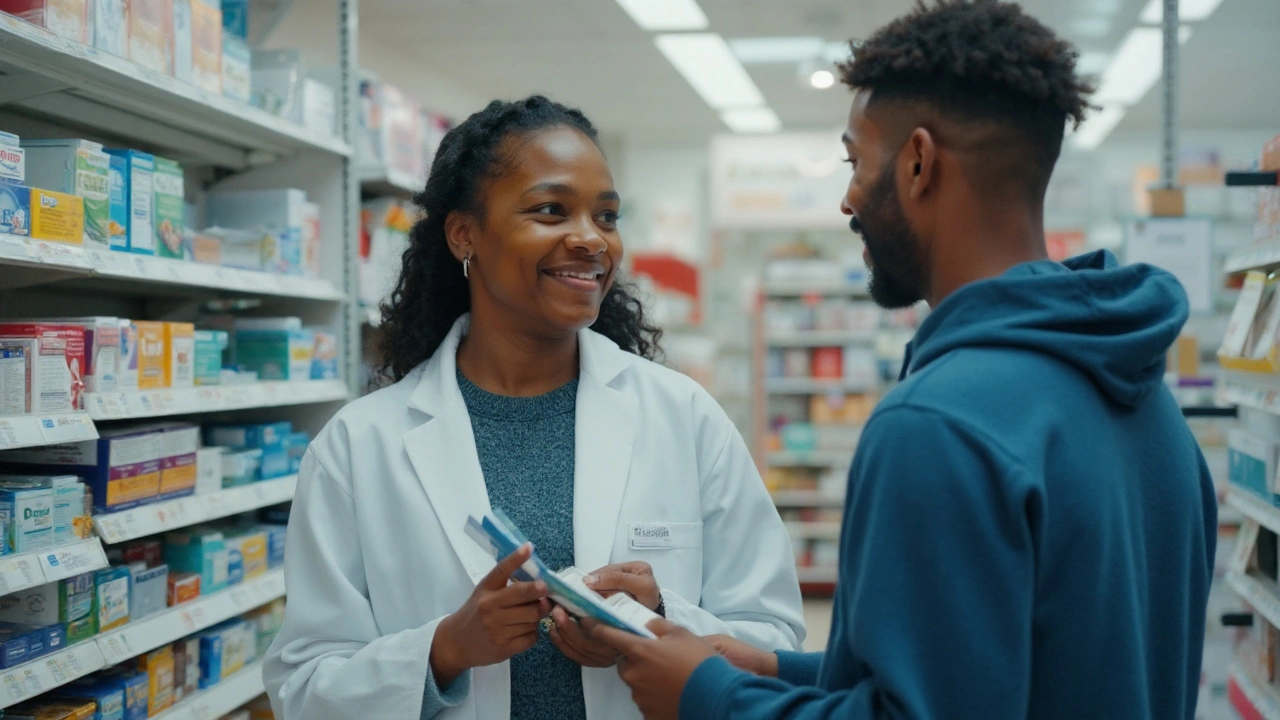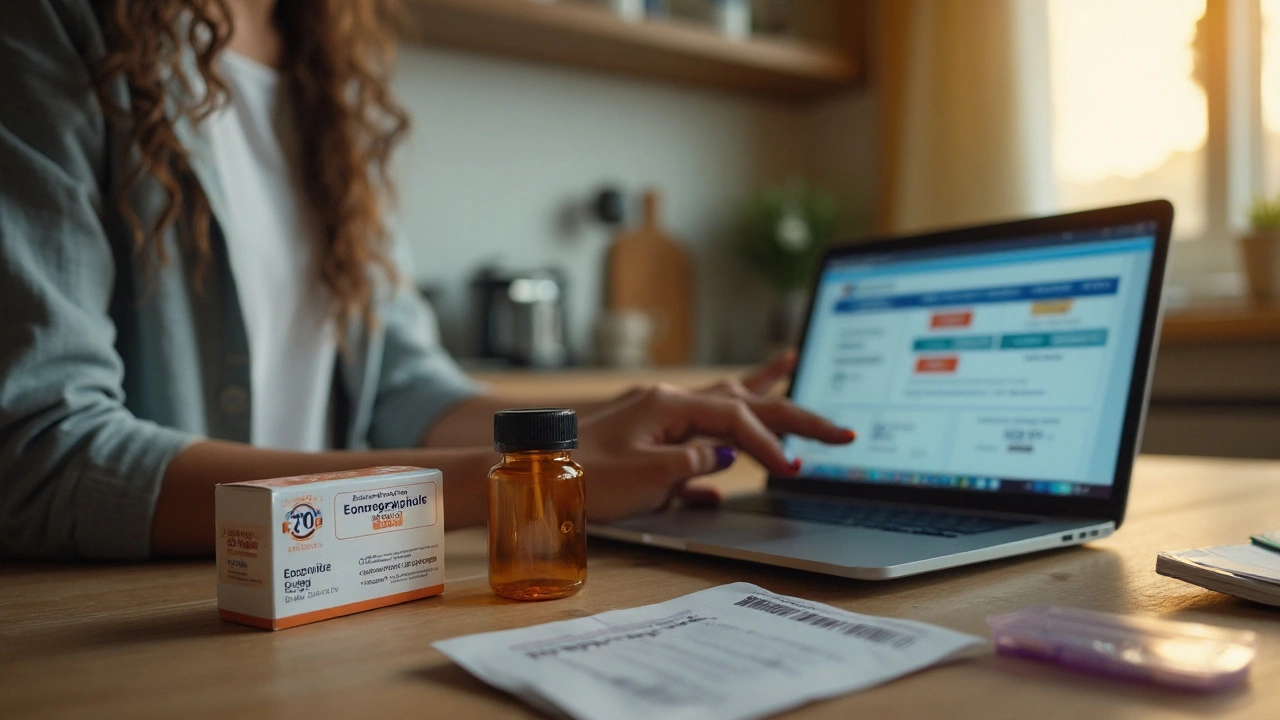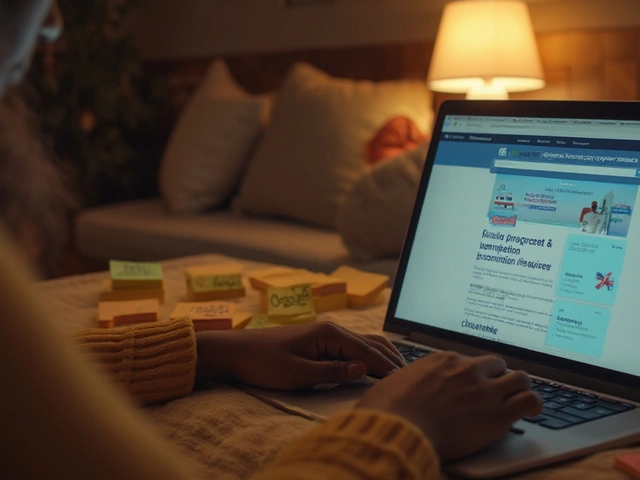You want the lowest price on generic Nexium without getting scammed or stuck with a bottle that doesn’t work for your symptoms. You also don’t want to spend hours comparing sketchy sites. Here’s a simple, safe playbook for August 2025: what to buy, a fair price range today, how to check a pharmacy’s credentials in under two minutes, and when over-the-counter esomeprazole is enough versus when you need a prescription.
What you’re actually buying (and when OTC is enough)
Generic Nexium is esomeprazole, a proton pump inhibitor (PPI). It lowers stomach acid to relieve frequent heartburn and help heal acid-related damage. In the U.S., you’ll find two routes:
- Over-the-counter (OTC): Esomeprazole 20 mg delayed-release (often labeled “Nexium 24HR” or store-brand “Esomeprazole 20 mg”). OTC is for frequent heartburn, defined on the Drug Facts label as 2 or more days per week. Typical course: 1 tablet/capsule every morning for 14 days. Don’t repeat the 14-day course more than once every 4 months unless your clinician says so.
- Prescription (Rx): Esomeprazole 20 mg or 40 mg delayed-release capsules or tablets. Indications include gastroesophageal reflux disease (GERD), erosive esophagitis, risk reduction of NSAID-associated ulcers, and as part of combination therapy for H. pylori. Dosing and duration depend on diagnosis; follow your clinician’s plan.
Core specs to know before you click “add to cart”:
- Ingredient: Esomeprazole magnesium (delayed-release). It’s the same active ingredient as brand-name Nexium.
- Forms you’ll see: Delayed-release capsules or tablets (most common), and sometimes granules for suspension (Rx). OTC is almost always 20 mg DR capsules or tablets.
- How it works: It turns off acid pumps in your stomach. Full effect builds over 1-4 days. It won’t relieve symptoms instantly like antacids do.
- How to take: Take on an empty stomach, about 30-60 minutes before breakfast. Swallow whole; don’t crush or chew delayed-release products. Some capsules can be opened and sprinkled on applesauce-check that product’s label.
- Who should talk to a clinician first: Adults over 55 with new or changing heartburn; anyone with alarm symptoms (trouble swallowing, black stools, vomiting blood, unexplained weight loss, persistent chest pain); people on blood thinners or HIV meds; or if OTC courses keep repeating with only partial relief.
What result should you expect? If you’re using OTC for frequent heartburn, many people feel clear improvement within 24-72 hours. If you need fast relief tonight, pair it with an antacid for immediate symptom control while the PPI ramps up. For long-standing GERD or erosive esophagitis, your prescriber may choose 20-40 mg daily for 4-8 weeks, then reassess.
Evidence and standards behind this: the FDA OTC Drug Facts for esomeprazole sets the 14-day course guidance; U.S. gastroenterology guidelines (for example, ACG GERD guidance) support PPIs as first-line therapy for frequent, troublesome reflux. The key is using the right dose and duration-and not using OTC PPIs indefinitely without a diagnosis.
How to pay less online (without getting burned)
Prices jump around-brand vs generic, OTC vs Rx, pack size, and who you buy from. Here’s the fast way to sniff out a fair price and a legit seller.
Fair price ranges in August 2025 (U.S.):
| Product | Typical pack | OTC or Rx | Typical online price (USD) | Notes |
|---|---|---|---|---|
| Esomeprazole 20 mg (generic, delayed-release) | 14-count (14-day course) | OTC | $7-$15 | Store brands are often at the low end; brand Nexium 24HR runs higher. |
| Esomeprazole 20 mg (generic, delayed-release) | 42-count (3 courses) | OTC | $18-$32 | Bulk often wins on cost per dose; check unit price. |
| Esomeprazole 40 mg (generic, delayed-release) | 30 capsules | Rx | $6-$25 (with common discount cards) | Cash “list price” can look huge on some sites; real pay-at-counter price is usually much lower with a free coupon. |
| Esomeprazole 20 mg (generic, delayed-release) | 90 capsules | Rx | $12-$45 (with discount) | 90-day fills usually beat 30-day on per-capsule cost. |
These ranges reflect big U.S. online retailers and licensed pharmacies as of today. Prices vary by region, manufacturer, and promotions.
Quick math to avoid overpaying:
- Compare cost per pill, not the box price. Divide total price by the pill count to get the true unit price.
- OTC: 20 mg once daily for 14 days = 14 pills. A 42-count box covers three courses. If you only need one course, two 14-count boxes might be cheaper than a 42-count depending on sales.
- Rx: Ask your prescriber for a 90-day script if appropriate-mail-order often drops the per-pill cost.
Where to buy safely:
- Licensed U.S. online pharmacies with a verifiable state pharmacy license and pharmacist access. Look for the National Association of Boards of Pharmacy (NABP) Digital Pharmacy accreditation seal or check their name on the NABP site. The FDA’s BeSafeRx program also lists safe-purchasing criteria.
- Major retailers’ websites (the same stores you’d trust in person). They stock store-brand esomeprazole that’s FDA-approved with an NDC number on the label.
- For Rx doses: the site should require a valid prescription from a licensed prescriber. If a website offers prescription PPIs without a prescription, that’s a red flag.
Payment and coverage tips:
- Use FSA/HSA dollars for OTC or Rx if your plan allows (most do with kept receipts; some require a prescription for OTC reimbursement).
- Insurance often doesn’t cover OTC. For Rx esomeprazole, check both your plan’s copay and a cash-price coupon-surprisingly, the coupon price can beat your insurance copay.
- Watch shipping fees. A $6 product with $7 shipping isn’t a deal. Many sellers offer free shipping at a threshold (e.g., $25).
- Beware of “subscription traps.” Auto-refills are convenient if you truly need ongoing therapy-but set a reminder to reassess after 14 days for OTC or at your follow-up date for Rx.
Fast price-hunt workflow (5 minutes):
- Decide OTC vs Rx. If you have frequent heartburn without alarm symptoms, start with OTC 20 mg, 14 days. If you’ve got a diagnosis requiring Rx or need 40 mg, go Rx.
- Choose pack size. If you’re unsure you’ll need more than one OTC course, start with 14-count.
- Check two trusted retailers and one licensed online pharmacy. Sort by unit price, then check shipping and delivery time.
- For Rx: run the script through your plan AND a reputable cash-coupon tool at checkout to see which is lower. Many pharmacies honor those discounts.
- Verify the product’s NDC on the listing or box photo. Confirm delayed-release and the dose.
- Only then, pay-credit card or trusted digital wallet for fraud protection.
Deal-breakers I skip instantly: no physical address or license info, prices that are way below everyone else without a clear reason, “free doctor” sites pushing Rx PPIs without a real evaluation, or sellers shipping from unknown warehouses overseas for U.S. customers. Counterfeit risk is highest when you mix rock-bottom prices with zero transparency.

Safety checklist: side effects, interactions, and how to stay out of trouble
Esomeprazole is widely used and effective, but no acid-lowering drug is truly “set and forget.” Here’s the short list I run through before I order and when I start a course.
Common side effects: headache, diarrhea or constipation, nausea, gas, abdominal pain. These are usually mild and settle within a few days. Taking it before breakfast at the same time each day keeps your acid rhythm predictable, which also helps side effects feel less random.
Stop and get medical care if you notice: severe stomach pain, persistent diarrhea, black stools, blood in vomit, chest pain, choking, rash with fever, swelling of face/lips/tongue, or severe dizziness. For chest pain, don’t assume it’s reflux-seek emergency care.
Drug interactions that actually matter in real life:
- Clopidogrel (Plavix): Esomeprazole can reduce activation of clopidogrel by inhibiting CYP2C19. If you’re on clopidogrel after a stent or for stroke prevention, ask your cardiology team which acid medicine is acceptable for you. Some prefer pantoprazole or an H2 blocker.
- Warfarin: PPIs can increase warfarin levels in some people. If you start or stop esomeprazole, tell your anticoagulation clinic; they may check INR sooner.
- High-dose methotrexate: PPIs may reduce methotrexate clearance at oncology doses. This is a prescriber discussion.
- Atazanavir, nelfinavir (HIV meds): Stomach acid is key for absorption. PPIs can reduce levels. This needs specialist input.
- Drugs needing acid for absorption (ketoconazole, itraconazole) can be less effective with a PPI on board.
- St. John’s wort and strong enzyme inducers can change esomeprazole levels; mention supplements to your clinician.
Longer-term risks the FDA and major guidelines flag:
- Low magnesium if used for many months; watch for muscle cramps, tremors, or heart rhythm changes if you’re on long-term therapy.
- Vitamin B12 and iron absorption can drop with chronic acid suppression.
- Bone fracture risk has been reported with prolonged high-dose PPI use in older adults; lifestyle, calcium/vitamin D, and dose minimization matter.
- Kidney issues (including interstitial nephritis) are rare but real. If you develop new swelling, decreased urine, or unusual fatigue, get checked.
- Infections like C. difficile can happen with gut microbiome changes; this risk goes up with antibiotic use.
Practical ways to cut risk:
- Use the lowest effective dose for the shortest time that keeps symptoms controlled, as major gastroenterology guidelines advise.
- When stopping after a long course, taper if you can to dodge “rebound” acid: for example, take it every other day for a week while adding bedtime famotidine, then stop.
- Pair medication with lifestyle upgrades that actually move the needle: a 10-15% weight loss if overweight, raising the head of your bed 6-8 inches, not eating within 3 hours of sleep, and cutting back on smoking and alcohol. These aren’t just nice-to-haves-they can reduce your need for daily PPIs.
- Pregnancy and breastfeeding: available data haven’t shown a major risk signal for esomeprazole, but your OB team should be in the loop; they may choose an H2 blocker first-line depending on your case.
Credible sources behind all this include the FDA Drug Facts labeling and safety communications on PPIs, and guideline statements from the American College of Gastroenterology. I follow those when advising friends or family on whether to stay OTC or ask for a prescription.
What else compares-and how to choose fast
Esomeprazole is great, but it’s not the only game in town. Your two big categories are other PPIs and H2 blockers. Which one should you pick for price, speed, and interactions?
Closest PPI alternatives:
- Omeprazole (OTC/Rx): Often the cheapest PPI per dose. Similar effectiveness to esomeprazole for many people. Interacts with clopidogrel like esomeprazole does.
- Lansoprazole (OTC/Rx): Good potency, often mid-priced. Fewer clopidogrel concerns than esomeprazole/omeprazole, though always confirm with your clinician.
- Pantoprazole (Rx; OTC availability varies by region): Often chosen if you need a PPI and you’re on clopidogrel because its CYP2C19 inhibition is milder.
- Rabeprazole (Rx): Potent, generally well-tolerated; pricing varies. More common in Rx settings.
H2 blocker alternative:
- Famotidine (OTC/Rx): Faster relief for many people within 30-60 minutes, but not as potent for healing erosive disease. Great as a bedtime add-on if nighttime reflux breaks through a PPI. Cost is usually low and stable.
How I choose in practice:
- Need fast relief today and only occasional heartburn? Take famotidine or an antacid now; if heartburn is frequent (2+ days a week), start a 14-day PPI course in the morning.
- On clopidogrel? Ask about pantoprazole or famotidine instead of esomeprazole/omeprazole.
- Price-first shopper with no special interactions? Compare unit prices for OTC esomeprazole vs omeprazole. If one is 30-40% cheaper, I try that first.
- Nighttime symptoms only? Sometimes a bedtime famotidine works fine without a daytime PPI.
Not sure which to pick? Call the pharmacy’s counseling line. A five-minute chat can save you money and a return label.
Ready to order? Use this quick, ethical checklist so you buy the right thing, from the right place, at the right price:
- Decide your path: OTC 20 mg for a 14-day course, or Rx if your clinician prescribed it.
- Verify the pharmacy: look for the NABP Digital Pharmacy seal or check the pharmacy’s license on your state board site. Confirm a U.S. phone number for pharmacist counseling.
- Confirm the label: “Esomeprazole magnesium,” “delayed-release,” and the dose. Check the NDC in the listing photos.
- Run the numbers: compare unit prices, shipping, and delivery time. Avoid surprise fees at checkout.
- Double-check interactions: clopidogrel, warfarin, high-dose methotrexate, HIV meds, and any antifungals-if yes, speak to a clinician.
- Place your order and set a reminder: daily dose before breakfast for 14 days if OTC. Reassess symptoms after the course.
If you need a one-line search phrase that hits the target, this is it: buy generic nexium online. Use it with the safeguards above, and you’ll land on legit, well-priced listings instead of the sketchy stuff.
One last smart move: if you plan to use PPIs long term, get a formal diagnosis. That unlocks better dosing plans, checks for complications like esophagitis or Barrett’s, and helps you taper later instead of bouncing between flares. Your wallet and your gut will thank you.
Sources I trust for this topic (no links, just names you can search): U.S. FDA Drug Facts Label for Esomeprazole 20 mg OTC; FDA BeSafeRx; National Association of Boards of Pharmacy (NABP) Digital Pharmacy; American College of Gastroenterology GERD Guidelines; and standard pharmacology references for drug interactions.





Karen Ballard
August 22, 2025 AT 01:46Quick tip that saved me money when I switched to generic esomeprazole: always check the NDC in listing photos before checkout and screenshot it for your records, then compare that code to a major retailer’s listing to confirm the product matches.
OTC 14-count is perfect for testing whether a PPI actually helps your pattern of heartburn, and that avoids knee‑jerk bulk buys that end up in the medicine cabinet unused 🙃.
If you use FSA/HSA, keep the receipt and the box photo - some plans ask for a script for OTC reimbursement, so you’ll want evidence at hand.
Gina Lola
August 24, 2025 AT 03:46Unit pricing is the metric people sleep on but it’s the only one that matters for rational procurement of meds.
OTC 20 mg for a 14‑day diagnostic run is a low-friction intervention and it yields high information value compared to immediately locking into a 90‑day RX supply.
Also when evaluating online sellers, prioritize sites with verifiable state licensing and an NDC photo over cheap marketplaces with no license info; regulatory footprint equals accountability.
Leah Hawthorne
August 24, 2025 AT 04:46Following that workflow pays off in practice.
I once bought a 90-count Rx because the list price looked nice, then the cash coupon at checkout beat my insurer’s copay anyway, so I returned the insurer claim and used the coupon - saved about 70 bucks.
Takeaway: don’t assume insurance always wins, run the script through both channels and pick the lower out‑of‑pocket number.
Also keep a simple calendar reminder to reassess symptoms after an OTC 14-day course so you don’t auto-refill unnecessarily.
Brian Mavigliano
September 4, 2025 AT 17:33PPIs are a curious mix of miracle and overuse, a pharmacological paradox wrapped in a coupon code.
They extinguish acid pumps with theatrical decisiveness but they also nudge the ecosystem of the gut in ways that matter over months and years, and people treat them like daily vitamins instead of targeted therapy.
That’s not a sermon, just an observation: the cheapest path isn’t always the wisest path when downstream monitoring is skipped.
Clopidogrel interactions are the classic example where the ledger of risks and benefits gets complicated fast, so cheaping out on a pill without clinician input can be false economy.
From a civic perspective it’s wild how opaque pharmacy pricing is; two clicks and you can be in a different price universe entirely.
Emily Torbert
September 4, 2025 AT 18:33yeah that clopidogrel thing is a big deal and often downplayed.
people on blood thinners gotta be flagged in the pharmacy notes and clinician loop, not just left to random online shoppers.
i always tell folks to print the drug interaction portion or save a screenshot and bring it to the pharmacist when picking up the rx.
Rashi Shetty
September 8, 2025 AT 04:53Regulatory compliance is non‑negotiable when it comes to medicines, and the buyer has a civic duty to demand transparency at every step.
Licensed pharmacies are required to display their state licence and provide pharmacist access, and those are not cosmetic details; they are safeguards that protect patients from adulterated or mislabeled products.
The NABP accreditation is not just a seal, it signifies a baseline of protocol adherence that reduces downstream clinical risk and preserves public trust in the medication supply chain.
OTC availability of esomeprazole is a pragmatic public health tool, but it carries with it the responsibility to limit use to recommended patterns and durations, as specified on the Drug Facts label.
Chronic, indefinite use of PPIs without diagnostic oversight is a structural problem that burdens the healthcare system and puts individuals at risk of nutrient deficiencies and other iatrogenic harms.
Clinicians should not abdicate their role by permitting open‑ended refills without reassessment, and patients should insist on follow‑up when therapy extends beyond the recommended diagnostic window.
When an online seller circumvents prescription requirements and offers clinical triage by opaque ‘‘telemedicine’’ services, that is not innovation; it is erosion of standards and a vector for harm.
Consumers must be literate in the basics: check NDCs, confirm delayed‑release labeling, verify magnesium salt terminology, and prioritize products with clear manufacturing lot information.
Payment mechanisms such as FSA/HSA should not be treated as loopholes to justify indiscriminate purchasing; receipts and documentation exist for a reason.
When counseling friends or family, I emphasize conservative stewardship of PPIs and insist on documented clinician rationale for any chronic regimen.
That conservatism is not fearmongering, it is actuarial prudence: small risks aggregated across populations become significant burdens.
Finally, for those in regions where counterfeit pharmaceuticals are common, the moral obligation is to source medicines from established, licensed distributors, and to report suspicious products to the relevant regulatory authorities so market integrity is protected.
Emojis are charming, but they do not substitute for licence verification and pharmacovigilance 🙂.
Yojana Geete
September 16, 2025 AT 07:20Nice concise checklist, saved to my phone.
Jason Peart
September 19, 2025 AT 18:40that long post about checks and NDCs hit hard and true, i kept a photo of my box and it legit helped when a pharmacy swapped manufacturers once and i got a weird side effect, saved me from a whole mess.
also logging symptom start dates and when you actually take the pill tells you if it is doing its job, little tracking goes a long way.